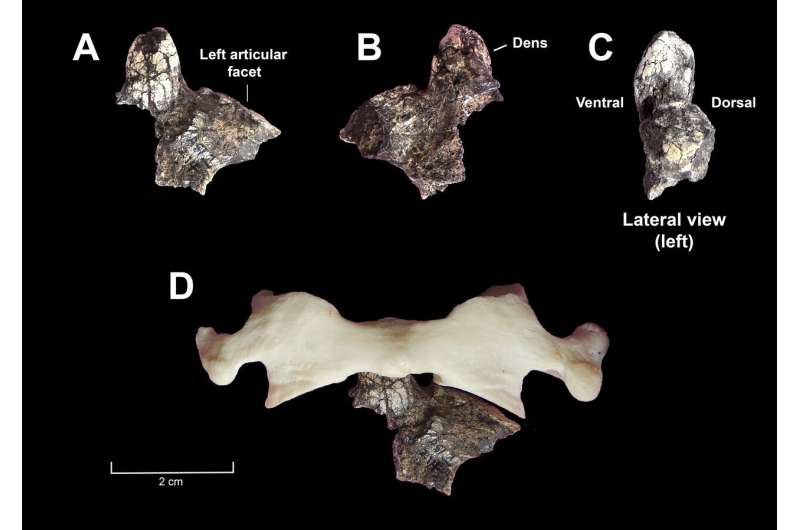Oldest axial fossils discovered for the genus Australopithecus

Scientists have published an article describing the oldest axial fossils yet discovered for the genus Australopithecus. Dated 4.2 million years ago, these and other fossils recovered from the Assa Issie site in the Middle Awash extend the known range of A. anamensis into northeastern Ethiopia. The fossils from the Assa Issie are extremely fragmentary, but each represents an important element previously unknown for the species Australopithecus anamensis.
In an upcoming article in the Journal of Human Evolution, paleoanthropologists Dr. Marc Meyer of Chaffey College and Scott Williams of New York University describe tell-tale signs that these early hominins had already evolved a human-like posture of the head and neck. "The bilobated facets of the first cervical vertebra are something we don't see in the great apes, but in humans is thought to provide a passive locking mechanism that keeps the head stable in erect posture," explains Meyer.
The scientists also point to the lack the pronounced retroglenoid tubercle of the great apes on two of the atlas (C1) fossils that indicate that like humans, anamensis lacked the atlantoclavicularis muscle, which would have reduced their capacity for climbing relative to the great apes—something scientists did not know until now.
Other features of the non-human ape spine are also absent in the hominin fossils, such as the ponticulus posticus, the bony form of a membrane in apes that protects the vertebral artery from being crushed when the head is cantilevered in front of the spine. The scientists report "lack of this feature in anamensis is consistent with a humanlike posture where the head is more centered above the spine".
The spinal column reveals other surprisingly human characters, such as an enlarged epiphyseal surface area that is a hallmark feature of bipedalism, as it improves the ability to resist the increased load magnitudes of upright posture. "Such a feature would also provide energy return during bipedal locomotion from the intervertebral discs in the form of elastic strain energy with rotary spinal movement" explain the scientists.
Finally, despite their great antiquity, like humans, the A. anamensis fossils from Issie exhibit an enlarged spinal canal compared to the apes. "This would confer an increase in the neurovascular contents of the canal, including the motor pool in the ventral horn of the australopith spinal cord well before the advent of genus Homo", says Meyer. The enlarged spinal canal provides the earliest evidence for an enlarged spinal cord in the hominin lineage and imparts significant neurological and vascular benefits for bipedal locomotion, and shatters the notion that spinal cord size in early hominins was small and apelike. This was another surprise, say the scientists, and provides evidence that a human-sized spinal cord evolved well before human brain size.
More information: Earliest axial fossils from the genus Australopithecus. Marc R. Meyer and Scott A. Williams. Journal of Human Evolution Volume 132, July 2019, Pages 189-214. doi.org/10.1016/j.jhevol.2019.05.004
Journal information: Journal of Human Evolution
Provided by Chaffey College





















